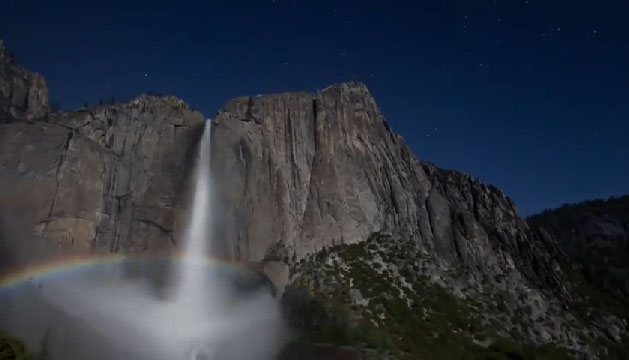Moonbows Over Yosemite Waterfalls Offer Dazzling Full Moon Sight

This month's full moon on Friday (July 15) may have been the center of attention for many skywatchers, but in California's Yosemite National Park, the full moon is just a tool for another amazing night sky sight: Moonbows.
According to a video released by park officials this month, the time around full moons are the best time to spot nighttime moonbows, also known as lunar rainbows, over some of Yosemite's most famous waterfalls.
"A lot of people don't realize that we even get rainbows at night in Yosemite," filmmaker Steve Bumgardner explained in the YouTube video, which he created for the Yosemite Nature Notes series. " If there's a full moon and the sky is clear, the moon, which is just reflected sunlight, is actually enough light to generate a rainbow at a place like Yosemite Falls."
The moonbows are created the same way as rainbows after a storm: light hits water droplets and refracts in its component spectrum of different colors.
During the day, rainbows are born when sunlight hits water vapor after a storm. But at many Yosemite National Park waterfalls, the spray from waterfalls and the full moon light combine in dazzling lunar rainbow displays.
These moonbows are best seen during the spring and summer seasons at Yosemite, park officials said in the video.
"Yosemite is a 24-hour park and its well-illustrated by the numbers of people who are going to go out all night long to take pictures of moonbows," said park ranger Bob Roney.
Get the Space.com Newsletter
Breaking space news, the latest updates on rocket launches, skywatching events and more!
Even famed naturalist John Muir wrote about moonbows over waterfalls, which he called "spray bows," in the 1800s, park officials said.
July's full moon occurred Friday at about 2:40 a.m. EDT (0640 GMT). It was known by several names, including the Buck Moon, Hay Moon and Mead Moon.
"From the night skies and Milky Way to the full moon rising to create these lunar rainbows, the beauty here doesn't end when the sun goes down," Bumgardner said. "You can have a unique experience 24 hours a day in Yosemite."
Roney agreed.
"It has its own romantic sense to it," he said. "It's ethereal."
Follow SPACE.com for the latest in space science and exploration news on Twitter @Spacedotcom and on Facebook.
Join our Space Forums to keep talking space on the latest missions, night sky and more! And if you have a news tip, correction or comment, let us know at: community@space.com.

Space.com is the premier source of space exploration, innovation and astronomy news, chronicling (and celebrating) humanity's ongoing expansion across the final frontier. Originally founded in 1999, Space.com is, and always has been, the passion of writers and editors who are space fans and also trained journalists. Our current news team consists of Editor-in-Chief Tariq Malik; Editor Hanneke Weitering, Senior Space Writer Mike Wall; Senior Writer Meghan Bartels; Senior Writer Chelsea Gohd, Senior Writer Tereza Pultarova and Staff Writer Alexander Cox, focusing on e-commerce. Senior Producer Steve Spaleta oversees our space videos, with Diana Whitcroft as our Social Media Editor.